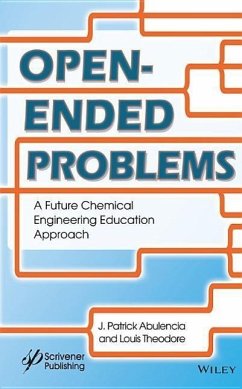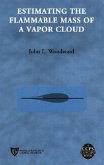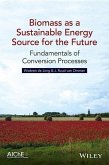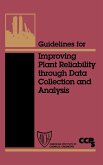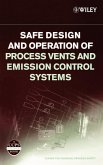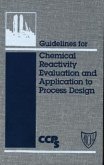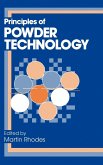James Patrick Abulencia, Louis Theodore
Open-Ended Problems
A Future Chemical Engineering Education Approach
James Patrick Abulencia, Louis Theodore
Open-Ended Problems
A Future Chemical Engineering Education Approach
- Gebundenes Buch
- Merkliste
- Auf die Merkliste
- Bewerten Bewerten
- Teilen
- Produkt teilen
- Produkterinnerung
- Produkterinnerung
Against a drumbeat of hopelessness about too much student debt and too few jobs requiring a college degree, "Smart is the New Rich: Money Guide for Millennials" is a realistic and optimistic road map for millennials to save more, navigate their careers, invest in the stock market, and pay their student loans all at the same time. TIME is a four-letter word of the very best kind for millennials. It is the single most important driver of wealth, and young people have it in spades. That's why "the time is now" for millennials to address their financial health and start planning their wealth. Just…mehr
Andere Kunden interessierten sich auch für
![A Science Career Against all Odds A Science Career Against all Odds]() Bernhard WunderlichA Science Career Against all Odds103,99 €
Bernhard WunderlichA Science Career Against all Odds103,99 €![Estimating the Flammable Mass of a Vapor Cloud Estimating the Flammable Mass of a Vapor Cloud]() John L WoodwardEstimating the Flammable Mass of a Vapor Cloud256,99 €
John L WoodwardEstimating the Flammable Mass of a Vapor Cloud256,99 €![Biomass as a Sustainable Energy Source for the Future Biomass as a Sustainable Energy Source for the Future]() Wiebren De JongBiomass as a Sustainable Energy Source for the Future154,99 €
Wiebren De JongBiomass as a Sustainable Energy Source for the Future154,99 €![Guidelines for Improving Plant Reliability Through Data Collection and Analysis Guidelines for Improving Plant Reliability Through Data Collection and Analysis]() Center for Chemical Process Safety (CCPS)Guidelines for Improving Plant Reliability Through Data Collection and Analysis256,99 €
Center for Chemical Process Safety (CCPS)Guidelines for Improving Plant Reliability Through Data Collection and Analysis256,99 €![Safe Design and Operation of Process Vents and Emission Control Systems Safe Design and Operation of Process Vents and Emission Control Systems]() Center for Chemical Process Safety (CCPS)Safe Design and Operation of Process Vents and Emission Control Systems188,99 €
Center for Chemical Process Safety (CCPS)Safe Design and Operation of Process Vents and Emission Control Systems188,99 €![Guidelines for Chemical Reactivity Evaluation and Application to Process Design Guidelines for Chemical Reactivity Evaluation and Application to Process Design]() Ccps (Center For Chemical Process Safety)Guidelines for Chemical Reactivity Evaluation and Application to Process Design182,99 €
Ccps (Center For Chemical Process Safety)Guidelines for Chemical Reactivity Evaluation and Application to Process Design182,99 €![Principles of Powder Technology Principles of Powder Technology]() Principles of Powder Technology891,99 €
Principles of Powder Technology891,99 €-
-
-
Against a drumbeat of hopelessness about too much student debt and too few jobs requiring a college degree, "Smart is the New Rich: Money Guide for Millennials" is a realistic and optimistic road map for millennials to save more, navigate their careers, invest in the stock market, and pay their student loans all at the same time. TIME is a four-letter word of the very best kind for millennials. It is the single most important driver of wealth, and young people have it in spades. That's why "the time is now" for millennials to address their financial health and start planning their wealth. Just as you'd buy a guidebook before a trip through Central America or Europe, this is a guidebook for young people travelling for the first time in the money world: at work, with friends and significant others, negotiating a raise, renting an apartment or saving to buy a house, and of course... retirement. Credit, debt, savings, investment, taxes, mortgages--this book is an all-in-one explanation of these topics and more, with checklists and other tools to make the plan clear and easy. Author Christine Romans is a CNN journalist who has been reporting on the events that have shaped the millennial generation, including the terrorist attacks of September 11, 2001, the financial crisis of 2008, President Barack Obama's election and reelection, and the wave of protests from Occupy Wall Street to the Arab Spring to #JeSuisCharlie. These events have shaped the millennial generation- a generation that values experiences over materialism and wants more out of their jobs and money than the credit-fueled mirage that came before them.
Hinweis: Dieser Artikel kann nur an eine deutsche Lieferadresse ausgeliefert werden.
Hinweis: Dieser Artikel kann nur an eine deutsche Lieferadresse ausgeliefert werden.
Produktdetails
- Produktdetails
- Verlag: Wiley
- Seitenzahl: 608
- Erscheinungstermin: 20. April 2015
- Englisch
- Abmessung: 243mm x 164mm x 34mm
- Gewicht: 1136g
- ISBN-13: 9781118946046
- ISBN-10: 1118946049
- Artikelnr.: 41025027
- Herstellerkennzeichnung
- Libri GmbH
- Europaallee 1
- 36244 Bad Hersfeld
- gpsr@libri.de
- Verlag: Wiley
- Seitenzahl: 608
- Erscheinungstermin: 20. April 2015
- Englisch
- Abmessung: 243mm x 164mm x 34mm
- Gewicht: 1136g
- ISBN-13: 9781118946046
- ISBN-10: 1118946049
- Artikelnr.: 41025027
- Herstellerkennzeichnung
- Libri GmbH
- Europaallee 1
- 36244 Bad Hersfeld
- gpsr@libri.de
LOUIS THEODORE, EngScD, is a retired professor of chemical engineering (50 years). He is the author of several Wiley publications, including Fluid Flow for the Practicing Chemical Engineer, Thermodynamics for the Practicing Engineer, Mass Transfer Operations for the Practicing Engineer, and Air Pollution Control Equipment Calculations. Dr. Theodore is also a contributor to Perry's Chemical Engineer's Handbook. J. Patrick Abulencia is an Associate Professor in the Department of Chemical Engineering at Manhattan College. He received his B.S. degree in Chemical Engineering from Manhattan College, and his Ph.D. in Chemical and Biomolecular Engineering from Johns Hopkins University. Dr. Abulencia typically teaches material and energy balances, thermodynamics, fluid flow, and unit operations laboratory. His research interests include water filtration, life cycle assessment, and engineering education. He co-authored with Louis Theodore Fluid Flow for the Practicing Chemical Engineer.
Preface xix
Acknowledgements xxi
Part I: Introduction to the Open-Ended Problem Approach 1
Part II: Chemical Engineering Topics 13
1 Materials Science and Engineering 15
1.1 Overview 15
1.2 Crystallography of Perfect Crystals (CPC) 17
1.3 Crystallography of Real Crystals (CRC) 25
1.4 Materials of Construction 27
1.5 Resistivity 28
1.6 Semiconductors 29
1.7 Illustrative Open-Ended Problems 30
1.8 Open-Ended Problems 34
References 37
2 Applied Mathematics 39
2.1 Overview 39
2.2 Differentiation and Integration 41
2.3 Simultaneous Linear Algebraic Equations 42
2.4 Nonlinear Algebraic Equations 43
2.5 Ordinary and Partial Differential Equation 44
2.6 Optimization 45
2.7 Illustrative Open-Ended Problems 48
2.8 Open-Ended Problems 51
References 56
3 Stoichiometry 59
3.1 Overview 59
3.2 The Conservation Law 60
3.3 Conservation of Mass, Energy, and Momentum 62
3.4 Stoichiometry 64
3.5 Illustrative Open-Ended Problems 67
3.6 Open-Ended Problems 72
References 77
4 Thermodynamics 79
4.1 Overview 79
4.2 Enthalpy Effects 81
4.3 Second Law Calculations 84
4.4 Phase Equilibrium 86
4.5 Chemical Reaction Equilibrium 88
4.6 Illustrative Open-Ended Problems 90
4.7 Open-Ended Problems 94
References 97
5 Fluid Flow 99
5.1 Overview 99
5.2 Basic Laws 101
5.3 Key Fluid Flow Equations 102
5.4 Fluid-Particle Applications 108
5.5 Illustrative Open-Ended Problems 110
5.6 Open-Ended Problems 114
References 118
6 Heat Transfer 119
6.1 Overview 119
6.2 Conduction 121
6.3 Convection 122
6.4 Radiation 125
6.5 Condensation, Boiling, Refrigeration, and Cryogenics 126
6.6 Heat Exchangers 127
6.7 Illustrative Open-Ended Problems 129
6.8 Open-Ended Problems 134
References 139
7 Mass Transfer Operations 141
7.1 Overview 141
7.2 Absorption 143
7.3 Adsorption 148
7.4 Distillation 152
7.5 Other Mass Transfer Processes 158
7.6 Illustrative Open-Ended Problems 160
7.7 Open-Ended Problems 163
References 166
8 Chemical Reactors 169
8.1 Overview 169
8.2 Chemical Kinetics 171
8.3 Batch Reactors 174
8.4 Continuous Stirred Tank Reactors (CSTRs) 176
8.5 Tubular Flow Reactors 178
8.6 Catalytic Reactors 181
8.7 Thermal Effects 184
8.8 Illustrative Open-Ended Problems 187
8.9 Open-Ended Problems 192
References 196
9 Process Control and Instrumentation 197
9.1 Overview 197
9.2 Process Control Fundamentals 199
9.3 Feedback Control 203
9.4 Feedforward Control 204
9.5 Cascade Control 205
9.6 Alarms and Trips 206
9.7 Illustrative Open-Ended Problems 207
9.8 Open-Ended Problems 209
References 212
10 Economics and Finance
10.1 Overview 213
10.2 Capital Costs 216
10.3 Operating Costs 217
10.4 Project Evaluation 218
10.5 Perturbation Studies in Optimization 219
10.6 Principles of Accounting 220
10.7 Illustrative Open-Ended Problems 221
10.8 Open-Ended Problems 225
References 230
11 Plant Design 233
11.1 Overview 233
11.2 Preliminary Studies 235
11.3 Process Schematics 236
11.4 Material and Energy Balances 237
11.5 Equipment Design 238
11.6 Instrumentation and Controls 240
11.7 Design Approach 240
11.8 The Design Report 242
11.9 Illustrative Open-Ended Problems 243
11.10 Open-Ended Problems 246
References 250
12 Transport Phenomena 253
12.1 Overview 253
12.2 Development of Equations 255
12.3 The Transport Equations 256
12.4 Boundary and Initial Conditions 257
12.5 Solution of Equations 258
12.6 Analogies 258
12.7 Illustrative Open-Ended Problems 262
12.8 Open-Ended Problems 264
References 267
13 Project Management 269
13.1 Overview 269
13.2 Managing Project Activities 271
13.3 Initiating 272
13.4 Planning/Scheduling 273
13.5 Gantt Charts 275
13.6 Executing/Implementing 276
13.7 Monitoring/Controlling 277
13.8 Completion/Closing 278
13.9 Reports 279
13.10 Illustrative Open-Ended Problems 280
13.11 Open-Ended Problems 284
References 291
14 Environmental Management 293
14.1 Overview 293
14.2 Environmental Regulations 295
14.3 Classification, Sources, and Effects of Pollutants 296
14.4 Multimedia Concerns 297
14.5 ISO 14000 298
14.6 The Pollution Prevention Concept 299
14.7 Green Chemistry and Green Engineering 300
14.8 Sustainability 301
14.9 Illustrative Open-Ended Problems 302
14.10 Open-Ended Problems 309
References 315
15 Environmental Health and Hazard Risk Assessment 317
15.1 Overview 317
15.2 Safety and Accidents 319
15.3 Regulations 320
15.4 Emergency Planning and Response 321
15.5 Introduction to Environmental Risk Assessment 322
15.6 Health Risk Assessment 323
15.7 Hazard Risk Assessment 326
15.8 Illustrative Open-Ended Problems 329
15.9 Open-Ended Problems 333
References 341
16 Energy Management 343
16.1 Overview 343
16.2 Energy Resources 345
16.3 Energy Quantity/Availability 346
16.4 General Conservation Practices in Industry 346
16.5 General Domestic Conservation Applications 347
16.6 General Commercial Real Estate Conservation Applications 348
16.7 Architecture and the Role of Urban Planning 349
16.8 The U.S. Energy Policy/Independence 350
16.9 Illustrative Open-Ended Problems 352
16.10 Open-Ended Problems 355
References 361
17 Water Management 363
17.1 Overview 363
17.2 Water as a Commodity and as a Human Right 365
17.3 The Hydrologic Cycle 366
17.4 Water Usage 367
17.5 Regulatory Status 367
17.6 Acid Rain 370
17.7 Treatment Processes 371
17.8 Future Concerns 372
17.9 Illustrative Open-Ended Problems 373
17.10 Open-Ended Problems 376
References 381
18 Biochemical Engineering 83
18.1 Overview 383
18.2 Enzyme and Microbial Kinetics 385
18.3 Enzyme Reaction Mechanisms 386
18.4 Effectiveness Factor 389
18.5 Design Procedures 391
18.6 Illustrative Open-Ended Problems 394
18.7 Open-Ended Problems 399
References 403
19 Probability and Statistics 405
19.1 Overview 405
19.2 Probability Definitions and Interpretations 407
19.3 Introduction to Probability Distributions 408
19.4 Discrete and Continuous Probability Distributions 410
19.5 Contemporary Statistics 410
19.6 Regression Analysis (3) 411
19.7 Analysis of Variance 412
19.8 Illustrative Open-Ended Problems 413
19.9 Open-Ended Problems 418
References 425
20 Nanotechnology 427
20.1 Overview 427
20.2 Early History 429
20.3 Fundamentals and Basic Principles 429
20.4 Nanomaterials 430
20.5 Production Methods 431
20.6 Current Applications 432
20.7 Environmental Concerns 433
20.8 Future Prospects 434
20.9 Illustrative Open-Ended Problems 436
20.10 Open-Ended Problems 440
References 443
21 Legal Considerations 445
21.1 Overview 445
21.2 Intellectual Property Law 447
21.3 Contract Law 448
21.4 Tort Law 448
21.5 Patents 449
21.6 Infringement and Interferences 451
21.7 Copyrights 452
21.8 Trademarks 453
21.9 The Engineering Professional Licensing Process 454
21.10 Illustrative Open-Ended Problems 454
21.11 Open-Ended Problems 457
22 Ethics 463
22.1 Overview 463
22.2 The Present State 464
22.3 Moral Issues 466
22.4 Engineering Ethics 467
22.5 Environmental Justice 468
22.6 Illustrative Open-Ended Problems 470
22.7 Open-Ended Problems 473
References 480
Part III: Term Projects 483
23 Term Projects (2): Applied Mathematics 485
23.1 Term Project 23.1 486
23.2 Term Project 23.2 487
References 488
24 Term Projects (2): Stoichiometry 489
24.1 Term Project 24.1 490
24.2 Chemical Plant Solid Waste 493
Reference 493
25 Term Projects (2): Thermodynamics 495
25.1 Estimating Combustion Temperatures 496
25.2 Generating Entropy Data 496
References 497
26 Term Projects (6): Fluid Flow 499
26.1 Pressure Drop - Velocity - Mesh Size Correlation 500
26.2 Fanning?s Friction Factor: Equation Form 500
26.3 An Improved Pressure Drop and Flooding Correlation 503
26.4 Ventilation Model I 505
26.5 Ventilation Model II 506
26.6 Two ? Phase Flow 506
27 Term Projects (4): Heat Transfer 509
27.1 Wilson?s Method 510
27.2 Heat Exchanger Network I 511
27.3 Heat Exchanger Network II 513
27.4 Heat Exchanger Network III 514
References 515
28 Term Projects (5): Mass Transfer Operations 517
28.1 An Improved Absorber Design Procedure 518
28.2 An Improved Adsorber Design Procedure 519
28.3 Multicomponent Distillation Calculations 520
28.4 A New Liquid-Liquid Extraction Process 523
28.5 Designing and Predicting the Performance of Cooling Towers 525
References 526
29 Term Projects (2): Chemical Reactors 529
29.1 Minimizing Volume Requirements for CSTRs in Series I 530
29.2 Minimizing Volume Requirements for CSTRs in Series II 531
References 531
30 Term Projects (4): Plant Design 533
30.1 Chemical Plant Shipping Facilities 534
30.2 Plant Tank Farms 535
30.3 Chemical Plant Storage Requirements 536
30.4 Inside Battery Limits (ISBL) and Process Flow Approach 538
References 541
31 Term Projects (4): Environmental Management 543
31.1 Dissolve The USEPA 544
31.2 Solving Your Town's Sludge Problem 547
31.3 Benzene Underground Storage Tank Leak 549
31.4 An Improved MSDS Sheet 551
32 Term Projects (4): Health and Hazard Risk Assessment 553
32.1 Nuclear Waste Management 554
32.2 An Improved Risk Management Program 555
32.3 Bridge Rail Accident: Fault and Event Tree Analysis 557
32.4 HAZOP: Tank Car Loading Facility 558
References 560
33 Term Projects (3): Unit Operations Laboratory Design Projects 561
33.1 Hand Pump 562
33.2 Rooftop Garden Bed 563
33.3 Hydration Station Counter 564
Reference 566
34 Term Projects (4): Miscellaneous Topics 567
34.1 Standardizing Project Management 568
34.2 Monte Carlo Simulation: Bus Section Failures in Electrostatic
Precipitators 569
34.3 Hurricane and Flooding Concerns 570
34.4 Meteorites 571
References 573
Index 575
Acknowledgements xxi
Part I: Introduction to the Open-Ended Problem Approach 1
Part II: Chemical Engineering Topics 13
1 Materials Science and Engineering 15
1.1 Overview 15
1.2 Crystallography of Perfect Crystals (CPC) 17
1.3 Crystallography of Real Crystals (CRC) 25
1.4 Materials of Construction 27
1.5 Resistivity 28
1.6 Semiconductors 29
1.7 Illustrative Open-Ended Problems 30
1.8 Open-Ended Problems 34
References 37
2 Applied Mathematics 39
2.1 Overview 39
2.2 Differentiation and Integration 41
2.3 Simultaneous Linear Algebraic Equations 42
2.4 Nonlinear Algebraic Equations 43
2.5 Ordinary and Partial Differential Equation 44
2.6 Optimization 45
2.7 Illustrative Open-Ended Problems 48
2.8 Open-Ended Problems 51
References 56
3 Stoichiometry 59
3.1 Overview 59
3.2 The Conservation Law 60
3.3 Conservation of Mass, Energy, and Momentum 62
3.4 Stoichiometry 64
3.5 Illustrative Open-Ended Problems 67
3.6 Open-Ended Problems 72
References 77
4 Thermodynamics 79
4.1 Overview 79
4.2 Enthalpy Effects 81
4.3 Second Law Calculations 84
4.4 Phase Equilibrium 86
4.5 Chemical Reaction Equilibrium 88
4.6 Illustrative Open-Ended Problems 90
4.7 Open-Ended Problems 94
References 97
5 Fluid Flow 99
5.1 Overview 99
5.2 Basic Laws 101
5.3 Key Fluid Flow Equations 102
5.4 Fluid-Particle Applications 108
5.5 Illustrative Open-Ended Problems 110
5.6 Open-Ended Problems 114
References 118
6 Heat Transfer 119
6.1 Overview 119
6.2 Conduction 121
6.3 Convection 122
6.4 Radiation 125
6.5 Condensation, Boiling, Refrigeration, and Cryogenics 126
6.6 Heat Exchangers 127
6.7 Illustrative Open-Ended Problems 129
6.8 Open-Ended Problems 134
References 139
7 Mass Transfer Operations 141
7.1 Overview 141
7.2 Absorption 143
7.3 Adsorption 148
7.4 Distillation 152
7.5 Other Mass Transfer Processes 158
7.6 Illustrative Open-Ended Problems 160
7.7 Open-Ended Problems 163
References 166
8 Chemical Reactors 169
8.1 Overview 169
8.2 Chemical Kinetics 171
8.3 Batch Reactors 174
8.4 Continuous Stirred Tank Reactors (CSTRs) 176
8.5 Tubular Flow Reactors 178
8.6 Catalytic Reactors 181
8.7 Thermal Effects 184
8.8 Illustrative Open-Ended Problems 187
8.9 Open-Ended Problems 192
References 196
9 Process Control and Instrumentation 197
9.1 Overview 197
9.2 Process Control Fundamentals 199
9.3 Feedback Control 203
9.4 Feedforward Control 204
9.5 Cascade Control 205
9.6 Alarms and Trips 206
9.7 Illustrative Open-Ended Problems 207
9.8 Open-Ended Problems 209
References 212
10 Economics and Finance
10.1 Overview 213
10.2 Capital Costs 216
10.3 Operating Costs 217
10.4 Project Evaluation 218
10.5 Perturbation Studies in Optimization 219
10.6 Principles of Accounting 220
10.7 Illustrative Open-Ended Problems 221
10.8 Open-Ended Problems 225
References 230
11 Plant Design 233
11.1 Overview 233
11.2 Preliminary Studies 235
11.3 Process Schematics 236
11.4 Material and Energy Balances 237
11.5 Equipment Design 238
11.6 Instrumentation and Controls 240
11.7 Design Approach 240
11.8 The Design Report 242
11.9 Illustrative Open-Ended Problems 243
11.10 Open-Ended Problems 246
References 250
12 Transport Phenomena 253
12.1 Overview 253
12.2 Development of Equations 255
12.3 The Transport Equations 256
12.4 Boundary and Initial Conditions 257
12.5 Solution of Equations 258
12.6 Analogies 258
12.7 Illustrative Open-Ended Problems 262
12.8 Open-Ended Problems 264
References 267
13 Project Management 269
13.1 Overview 269
13.2 Managing Project Activities 271
13.3 Initiating 272
13.4 Planning/Scheduling 273
13.5 Gantt Charts 275
13.6 Executing/Implementing 276
13.7 Monitoring/Controlling 277
13.8 Completion/Closing 278
13.9 Reports 279
13.10 Illustrative Open-Ended Problems 280
13.11 Open-Ended Problems 284
References 291
14 Environmental Management 293
14.1 Overview 293
14.2 Environmental Regulations 295
14.3 Classification, Sources, and Effects of Pollutants 296
14.4 Multimedia Concerns 297
14.5 ISO 14000 298
14.6 The Pollution Prevention Concept 299
14.7 Green Chemistry and Green Engineering 300
14.8 Sustainability 301
14.9 Illustrative Open-Ended Problems 302
14.10 Open-Ended Problems 309
References 315
15 Environmental Health and Hazard Risk Assessment 317
15.1 Overview 317
15.2 Safety and Accidents 319
15.3 Regulations 320
15.4 Emergency Planning and Response 321
15.5 Introduction to Environmental Risk Assessment 322
15.6 Health Risk Assessment 323
15.7 Hazard Risk Assessment 326
15.8 Illustrative Open-Ended Problems 329
15.9 Open-Ended Problems 333
References 341
16 Energy Management 343
16.1 Overview 343
16.2 Energy Resources 345
16.3 Energy Quantity/Availability 346
16.4 General Conservation Practices in Industry 346
16.5 General Domestic Conservation Applications 347
16.6 General Commercial Real Estate Conservation Applications 348
16.7 Architecture and the Role of Urban Planning 349
16.8 The U.S. Energy Policy/Independence 350
16.9 Illustrative Open-Ended Problems 352
16.10 Open-Ended Problems 355
References 361
17 Water Management 363
17.1 Overview 363
17.2 Water as a Commodity and as a Human Right 365
17.3 The Hydrologic Cycle 366
17.4 Water Usage 367
17.5 Regulatory Status 367
17.6 Acid Rain 370
17.7 Treatment Processes 371
17.8 Future Concerns 372
17.9 Illustrative Open-Ended Problems 373
17.10 Open-Ended Problems 376
References 381
18 Biochemical Engineering 83
18.1 Overview 383
18.2 Enzyme and Microbial Kinetics 385
18.3 Enzyme Reaction Mechanisms 386
18.4 Effectiveness Factor 389
18.5 Design Procedures 391
18.6 Illustrative Open-Ended Problems 394
18.7 Open-Ended Problems 399
References 403
19 Probability and Statistics 405
19.1 Overview 405
19.2 Probability Definitions and Interpretations 407
19.3 Introduction to Probability Distributions 408
19.4 Discrete and Continuous Probability Distributions 410
19.5 Contemporary Statistics 410
19.6 Regression Analysis (3) 411
19.7 Analysis of Variance 412
19.8 Illustrative Open-Ended Problems 413
19.9 Open-Ended Problems 418
References 425
20 Nanotechnology 427
20.1 Overview 427
20.2 Early History 429
20.3 Fundamentals and Basic Principles 429
20.4 Nanomaterials 430
20.5 Production Methods 431
20.6 Current Applications 432
20.7 Environmental Concerns 433
20.8 Future Prospects 434
20.9 Illustrative Open-Ended Problems 436
20.10 Open-Ended Problems 440
References 443
21 Legal Considerations 445
21.1 Overview 445
21.2 Intellectual Property Law 447
21.3 Contract Law 448
21.4 Tort Law 448
21.5 Patents 449
21.6 Infringement and Interferences 451
21.7 Copyrights 452
21.8 Trademarks 453
21.9 The Engineering Professional Licensing Process 454
21.10 Illustrative Open-Ended Problems 454
21.11 Open-Ended Problems 457
22 Ethics 463
22.1 Overview 463
22.2 The Present State 464
22.3 Moral Issues 466
22.4 Engineering Ethics 467
22.5 Environmental Justice 468
22.6 Illustrative Open-Ended Problems 470
22.7 Open-Ended Problems 473
References 480
Part III: Term Projects 483
23 Term Projects (2): Applied Mathematics 485
23.1 Term Project 23.1 486
23.2 Term Project 23.2 487
References 488
24 Term Projects (2): Stoichiometry 489
24.1 Term Project 24.1 490
24.2 Chemical Plant Solid Waste 493
Reference 493
25 Term Projects (2): Thermodynamics 495
25.1 Estimating Combustion Temperatures 496
25.2 Generating Entropy Data 496
References 497
26 Term Projects (6): Fluid Flow 499
26.1 Pressure Drop - Velocity - Mesh Size Correlation 500
26.2 Fanning?s Friction Factor: Equation Form 500
26.3 An Improved Pressure Drop and Flooding Correlation 503
26.4 Ventilation Model I 505
26.5 Ventilation Model II 506
26.6 Two ? Phase Flow 506
27 Term Projects (4): Heat Transfer 509
27.1 Wilson?s Method 510
27.2 Heat Exchanger Network I 511
27.3 Heat Exchanger Network II 513
27.4 Heat Exchanger Network III 514
References 515
28 Term Projects (5): Mass Transfer Operations 517
28.1 An Improved Absorber Design Procedure 518
28.2 An Improved Adsorber Design Procedure 519
28.3 Multicomponent Distillation Calculations 520
28.4 A New Liquid-Liquid Extraction Process 523
28.5 Designing and Predicting the Performance of Cooling Towers 525
References 526
29 Term Projects (2): Chemical Reactors 529
29.1 Minimizing Volume Requirements for CSTRs in Series I 530
29.2 Minimizing Volume Requirements for CSTRs in Series II 531
References 531
30 Term Projects (4): Plant Design 533
30.1 Chemical Plant Shipping Facilities 534
30.2 Plant Tank Farms 535
30.3 Chemical Plant Storage Requirements 536
30.4 Inside Battery Limits (ISBL) and Process Flow Approach 538
References 541
31 Term Projects (4): Environmental Management 543
31.1 Dissolve The USEPA 544
31.2 Solving Your Town's Sludge Problem 547
31.3 Benzene Underground Storage Tank Leak 549
31.4 An Improved MSDS Sheet 551
32 Term Projects (4): Health and Hazard Risk Assessment 553
32.1 Nuclear Waste Management 554
32.2 An Improved Risk Management Program 555
32.3 Bridge Rail Accident: Fault and Event Tree Analysis 557
32.4 HAZOP: Tank Car Loading Facility 558
References 560
33 Term Projects (3): Unit Operations Laboratory Design Projects 561
33.1 Hand Pump 562
33.2 Rooftop Garden Bed 563
33.3 Hydration Station Counter 564
Reference 566
34 Term Projects (4): Miscellaneous Topics 567
34.1 Standardizing Project Management 568
34.2 Monte Carlo Simulation: Bus Section Failures in Electrostatic
Precipitators 569
34.3 Hurricane and Flooding Concerns 570
34.4 Meteorites 571
References 573
Index 575
Preface xix
Acknowledgements xxi
Part I: Introduction to the Open-Ended Problem Approach 1
Part II: Chemical Engineering Topics 13
1 Materials Science and Engineering 15
1.1 Overview 15
1.2 Crystallography of Perfect Crystals (CPC) 17
1.3 Crystallography of Real Crystals (CRC) 25
1.4 Materials of Construction 27
1.5 Resistivity 28
1.6 Semiconductors 29
1.7 Illustrative Open-Ended Problems 30
1.8 Open-Ended Problems 34
References 37
2 Applied Mathematics 39
2.1 Overview 39
2.2 Differentiation and Integration 41
2.3 Simultaneous Linear Algebraic Equations 42
2.4 Nonlinear Algebraic Equations 43
2.5 Ordinary and Partial Differential Equation 44
2.6 Optimization 45
2.7 Illustrative Open-Ended Problems 48
2.8 Open-Ended Problems 51
References 56
3 Stoichiometry 59
3.1 Overview 59
3.2 The Conservation Law 60
3.3 Conservation of Mass, Energy, and Momentum 62
3.4 Stoichiometry 64
3.5 Illustrative Open-Ended Problems 67
3.6 Open-Ended Problems 72
References 77
4 Thermodynamics 79
4.1 Overview 79
4.2 Enthalpy Effects 81
4.3 Second Law Calculations 84
4.4 Phase Equilibrium 86
4.5 Chemical Reaction Equilibrium 88
4.6 Illustrative Open-Ended Problems 90
4.7 Open-Ended Problems 94
References 97
5 Fluid Flow 99
5.1 Overview 99
5.2 Basic Laws 101
5.3 Key Fluid Flow Equations 102
5.4 Fluid-Particle Applications 108
5.5 Illustrative Open-Ended Problems 110
5.6 Open-Ended Problems 114
References 118
6 Heat Transfer 119
6.1 Overview 119
6.2 Conduction 121
6.3 Convection 122
6.4 Radiation 125
6.5 Condensation, Boiling, Refrigeration, and Cryogenics 126
6.6 Heat Exchangers 127
6.7 Illustrative Open-Ended Problems 129
6.8 Open-Ended Problems 134
References 139
7 Mass Transfer Operations 141
7.1 Overview 141
7.2 Absorption 143
7.3 Adsorption 148
7.4 Distillation 152
7.5 Other Mass Transfer Processes 158
7.6 Illustrative Open-Ended Problems 160
7.7 Open-Ended Problems 163
References 166
8 Chemical Reactors 169
8.1 Overview 169
8.2 Chemical Kinetics 171
8.3 Batch Reactors 174
8.4 Continuous Stirred Tank Reactors (CSTRs) 176
8.5 Tubular Flow Reactors 178
8.6 Catalytic Reactors 181
8.7 Thermal Effects 184
8.8 Illustrative Open-Ended Problems 187
8.9 Open-Ended Problems 192
References 196
9 Process Control and Instrumentation 197
9.1 Overview 197
9.2 Process Control Fundamentals 199
9.3 Feedback Control 203
9.4 Feedforward Control 204
9.5 Cascade Control 205
9.6 Alarms and Trips 206
9.7 Illustrative Open-Ended Problems 207
9.8 Open-Ended Problems 209
References 212
10 Economics and Finance
10.1 Overview 213
10.2 Capital Costs 216
10.3 Operating Costs 217
10.4 Project Evaluation 218
10.5 Perturbation Studies in Optimization 219
10.6 Principles of Accounting 220
10.7 Illustrative Open-Ended Problems 221
10.8 Open-Ended Problems 225
References 230
11 Plant Design 233
11.1 Overview 233
11.2 Preliminary Studies 235
11.3 Process Schematics 236
11.4 Material and Energy Balances 237
11.5 Equipment Design 238
11.6 Instrumentation and Controls 240
11.7 Design Approach 240
11.8 The Design Report 242
11.9 Illustrative Open-Ended Problems 243
11.10 Open-Ended Problems 246
References 250
12 Transport Phenomena 253
12.1 Overview 253
12.2 Development of Equations 255
12.3 The Transport Equations 256
12.4 Boundary and Initial Conditions 257
12.5 Solution of Equations 258
12.6 Analogies 258
12.7 Illustrative Open-Ended Problems 262
12.8 Open-Ended Problems 264
References 267
13 Project Management 269
13.1 Overview 269
13.2 Managing Project Activities 271
13.3 Initiating 272
13.4 Planning/Scheduling 273
13.5 Gantt Charts 275
13.6 Executing/Implementing 276
13.7 Monitoring/Controlling 277
13.8 Completion/Closing 278
13.9 Reports 279
13.10 Illustrative Open-Ended Problems 280
13.11 Open-Ended Problems 284
References 291
14 Environmental Management 293
14.1 Overview 293
14.2 Environmental Regulations 295
14.3 Classification, Sources, and Effects of Pollutants 296
14.4 Multimedia Concerns 297
14.5 ISO 14000 298
14.6 The Pollution Prevention Concept 299
14.7 Green Chemistry and Green Engineering 300
14.8 Sustainability 301
14.9 Illustrative Open-Ended Problems 302
14.10 Open-Ended Problems 309
References 315
15 Environmental Health and Hazard Risk Assessment 317
15.1 Overview 317
15.2 Safety and Accidents 319
15.3 Regulations 320
15.4 Emergency Planning and Response 321
15.5 Introduction to Environmental Risk Assessment 322
15.6 Health Risk Assessment 323
15.7 Hazard Risk Assessment 326
15.8 Illustrative Open-Ended Problems 329
15.9 Open-Ended Problems 333
References 341
16 Energy Management 343
16.1 Overview 343
16.2 Energy Resources 345
16.3 Energy Quantity/Availability 346
16.4 General Conservation Practices in Industry 346
16.5 General Domestic Conservation Applications 347
16.6 General Commercial Real Estate Conservation Applications 348
16.7 Architecture and the Role of Urban Planning 349
16.8 The U.S. Energy Policy/Independence 350
16.9 Illustrative Open-Ended Problems 352
16.10 Open-Ended Problems 355
References 361
17 Water Management 363
17.1 Overview 363
17.2 Water as a Commodity and as a Human Right 365
17.3 The Hydrologic Cycle 366
17.4 Water Usage 367
17.5 Regulatory Status 367
17.6 Acid Rain 370
17.7 Treatment Processes 371
17.8 Future Concerns 372
17.9 Illustrative Open-Ended Problems 373
17.10 Open-Ended Problems 376
References 381
18 Biochemical Engineering 83
18.1 Overview 383
18.2 Enzyme and Microbial Kinetics 385
18.3 Enzyme Reaction Mechanisms 386
18.4 Effectiveness Factor 389
18.5 Design Procedures 391
18.6 Illustrative Open-Ended Problems 394
18.7 Open-Ended Problems 399
References 403
19 Probability and Statistics 405
19.1 Overview 405
19.2 Probability Definitions and Interpretations 407
19.3 Introduction to Probability Distributions 408
19.4 Discrete and Continuous Probability Distributions 410
19.5 Contemporary Statistics 410
19.6 Regression Analysis (3) 411
19.7 Analysis of Variance 412
19.8 Illustrative Open-Ended Problems 413
19.9 Open-Ended Problems 418
References 425
20 Nanotechnology 427
20.1 Overview 427
20.2 Early History 429
20.3 Fundamentals and Basic Principles 429
20.4 Nanomaterials 430
20.5 Production Methods 431
20.6 Current Applications 432
20.7 Environmental Concerns 433
20.8 Future Prospects 434
20.9 Illustrative Open-Ended Problems 436
20.10 Open-Ended Problems 440
References 443
21 Legal Considerations 445
21.1 Overview 445
21.2 Intellectual Property Law 447
21.3 Contract Law 448
21.4 Tort Law 448
21.5 Patents 449
21.6 Infringement and Interferences 451
21.7 Copyrights 452
21.8 Trademarks 453
21.9 The Engineering Professional Licensing Process 454
21.10 Illustrative Open-Ended Problems 454
21.11 Open-Ended Problems 457
22 Ethics 463
22.1 Overview 463
22.2 The Present State 464
22.3 Moral Issues 466
22.4 Engineering Ethics 467
22.5 Environmental Justice 468
22.6 Illustrative Open-Ended Problems 470
22.7 Open-Ended Problems 473
References 480
Part III: Term Projects 483
23 Term Projects (2): Applied Mathematics 485
23.1 Term Project 23.1 486
23.2 Term Project 23.2 487
References 488
24 Term Projects (2): Stoichiometry 489
24.1 Term Project 24.1 490
24.2 Chemical Plant Solid Waste 493
Reference 493
25 Term Projects (2): Thermodynamics 495
25.1 Estimating Combustion Temperatures 496
25.2 Generating Entropy Data 496
References 497
26 Term Projects (6): Fluid Flow 499
26.1 Pressure Drop - Velocity - Mesh Size Correlation 500
26.2 Fanning?s Friction Factor: Equation Form 500
26.3 An Improved Pressure Drop and Flooding Correlation 503
26.4 Ventilation Model I 505
26.5 Ventilation Model II 506
26.6 Two ? Phase Flow 506
27 Term Projects (4): Heat Transfer 509
27.1 Wilson?s Method 510
27.2 Heat Exchanger Network I 511
27.3 Heat Exchanger Network II 513
27.4 Heat Exchanger Network III 514
References 515
28 Term Projects (5): Mass Transfer Operations 517
28.1 An Improved Absorber Design Procedure 518
28.2 An Improved Adsorber Design Procedure 519
28.3 Multicomponent Distillation Calculations 520
28.4 A New Liquid-Liquid Extraction Process 523
28.5 Designing and Predicting the Performance of Cooling Towers 525
References 526
29 Term Projects (2): Chemical Reactors 529
29.1 Minimizing Volume Requirements for CSTRs in Series I 530
29.2 Minimizing Volume Requirements for CSTRs in Series II 531
References 531
30 Term Projects (4): Plant Design 533
30.1 Chemical Plant Shipping Facilities 534
30.2 Plant Tank Farms 535
30.3 Chemical Plant Storage Requirements 536
30.4 Inside Battery Limits (ISBL) and Process Flow Approach 538
References 541
31 Term Projects (4): Environmental Management 543
31.1 Dissolve The USEPA 544
31.2 Solving Your Town's Sludge Problem 547
31.3 Benzene Underground Storage Tank Leak 549
31.4 An Improved MSDS Sheet 551
32 Term Projects (4): Health and Hazard Risk Assessment 553
32.1 Nuclear Waste Management 554
32.2 An Improved Risk Management Program 555
32.3 Bridge Rail Accident: Fault and Event Tree Analysis 557
32.4 HAZOP: Tank Car Loading Facility 558
References 560
33 Term Projects (3): Unit Operations Laboratory Design Projects 561
33.1 Hand Pump 562
33.2 Rooftop Garden Bed 563
33.3 Hydration Station Counter 564
Reference 566
34 Term Projects (4): Miscellaneous Topics 567
34.1 Standardizing Project Management 568
34.2 Monte Carlo Simulation: Bus Section Failures in Electrostatic
Precipitators 569
34.3 Hurricane and Flooding Concerns 570
34.4 Meteorites 571
References 573
Index 575
Acknowledgements xxi
Part I: Introduction to the Open-Ended Problem Approach 1
Part II: Chemical Engineering Topics 13
1 Materials Science and Engineering 15
1.1 Overview 15
1.2 Crystallography of Perfect Crystals (CPC) 17
1.3 Crystallography of Real Crystals (CRC) 25
1.4 Materials of Construction 27
1.5 Resistivity 28
1.6 Semiconductors 29
1.7 Illustrative Open-Ended Problems 30
1.8 Open-Ended Problems 34
References 37
2 Applied Mathematics 39
2.1 Overview 39
2.2 Differentiation and Integration 41
2.3 Simultaneous Linear Algebraic Equations 42
2.4 Nonlinear Algebraic Equations 43
2.5 Ordinary and Partial Differential Equation 44
2.6 Optimization 45
2.7 Illustrative Open-Ended Problems 48
2.8 Open-Ended Problems 51
References 56
3 Stoichiometry 59
3.1 Overview 59
3.2 The Conservation Law 60
3.3 Conservation of Mass, Energy, and Momentum 62
3.4 Stoichiometry 64
3.5 Illustrative Open-Ended Problems 67
3.6 Open-Ended Problems 72
References 77
4 Thermodynamics 79
4.1 Overview 79
4.2 Enthalpy Effects 81
4.3 Second Law Calculations 84
4.4 Phase Equilibrium 86
4.5 Chemical Reaction Equilibrium 88
4.6 Illustrative Open-Ended Problems 90
4.7 Open-Ended Problems 94
References 97
5 Fluid Flow 99
5.1 Overview 99
5.2 Basic Laws 101
5.3 Key Fluid Flow Equations 102
5.4 Fluid-Particle Applications 108
5.5 Illustrative Open-Ended Problems 110
5.6 Open-Ended Problems 114
References 118
6 Heat Transfer 119
6.1 Overview 119
6.2 Conduction 121
6.3 Convection 122
6.4 Radiation 125
6.5 Condensation, Boiling, Refrigeration, and Cryogenics 126
6.6 Heat Exchangers 127
6.7 Illustrative Open-Ended Problems 129
6.8 Open-Ended Problems 134
References 139
7 Mass Transfer Operations 141
7.1 Overview 141
7.2 Absorption 143
7.3 Adsorption 148
7.4 Distillation 152
7.5 Other Mass Transfer Processes 158
7.6 Illustrative Open-Ended Problems 160
7.7 Open-Ended Problems 163
References 166
8 Chemical Reactors 169
8.1 Overview 169
8.2 Chemical Kinetics 171
8.3 Batch Reactors 174
8.4 Continuous Stirred Tank Reactors (CSTRs) 176
8.5 Tubular Flow Reactors 178
8.6 Catalytic Reactors 181
8.7 Thermal Effects 184
8.8 Illustrative Open-Ended Problems 187
8.9 Open-Ended Problems 192
References 196
9 Process Control and Instrumentation 197
9.1 Overview 197
9.2 Process Control Fundamentals 199
9.3 Feedback Control 203
9.4 Feedforward Control 204
9.5 Cascade Control 205
9.6 Alarms and Trips 206
9.7 Illustrative Open-Ended Problems 207
9.8 Open-Ended Problems 209
References 212
10 Economics and Finance
10.1 Overview 213
10.2 Capital Costs 216
10.3 Operating Costs 217
10.4 Project Evaluation 218
10.5 Perturbation Studies in Optimization 219
10.6 Principles of Accounting 220
10.7 Illustrative Open-Ended Problems 221
10.8 Open-Ended Problems 225
References 230
11 Plant Design 233
11.1 Overview 233
11.2 Preliminary Studies 235
11.3 Process Schematics 236
11.4 Material and Energy Balances 237
11.5 Equipment Design 238
11.6 Instrumentation and Controls 240
11.7 Design Approach 240
11.8 The Design Report 242
11.9 Illustrative Open-Ended Problems 243
11.10 Open-Ended Problems 246
References 250
12 Transport Phenomena 253
12.1 Overview 253
12.2 Development of Equations 255
12.3 The Transport Equations 256
12.4 Boundary and Initial Conditions 257
12.5 Solution of Equations 258
12.6 Analogies 258
12.7 Illustrative Open-Ended Problems 262
12.8 Open-Ended Problems 264
References 267
13 Project Management 269
13.1 Overview 269
13.2 Managing Project Activities 271
13.3 Initiating 272
13.4 Planning/Scheduling 273
13.5 Gantt Charts 275
13.6 Executing/Implementing 276
13.7 Monitoring/Controlling 277
13.8 Completion/Closing 278
13.9 Reports 279
13.10 Illustrative Open-Ended Problems 280
13.11 Open-Ended Problems 284
References 291
14 Environmental Management 293
14.1 Overview 293
14.2 Environmental Regulations 295
14.3 Classification, Sources, and Effects of Pollutants 296
14.4 Multimedia Concerns 297
14.5 ISO 14000 298
14.6 The Pollution Prevention Concept 299
14.7 Green Chemistry and Green Engineering 300
14.8 Sustainability 301
14.9 Illustrative Open-Ended Problems 302
14.10 Open-Ended Problems 309
References 315
15 Environmental Health and Hazard Risk Assessment 317
15.1 Overview 317
15.2 Safety and Accidents 319
15.3 Regulations 320
15.4 Emergency Planning and Response 321
15.5 Introduction to Environmental Risk Assessment 322
15.6 Health Risk Assessment 323
15.7 Hazard Risk Assessment 326
15.8 Illustrative Open-Ended Problems 329
15.9 Open-Ended Problems 333
References 341
16 Energy Management 343
16.1 Overview 343
16.2 Energy Resources 345
16.3 Energy Quantity/Availability 346
16.4 General Conservation Practices in Industry 346
16.5 General Domestic Conservation Applications 347
16.6 General Commercial Real Estate Conservation Applications 348
16.7 Architecture and the Role of Urban Planning 349
16.8 The U.S. Energy Policy/Independence 350
16.9 Illustrative Open-Ended Problems 352
16.10 Open-Ended Problems 355
References 361
17 Water Management 363
17.1 Overview 363
17.2 Water as a Commodity and as a Human Right 365
17.3 The Hydrologic Cycle 366
17.4 Water Usage 367
17.5 Regulatory Status 367
17.6 Acid Rain 370
17.7 Treatment Processes 371
17.8 Future Concerns 372
17.9 Illustrative Open-Ended Problems 373
17.10 Open-Ended Problems 376
References 381
18 Biochemical Engineering 83
18.1 Overview 383
18.2 Enzyme and Microbial Kinetics 385
18.3 Enzyme Reaction Mechanisms 386
18.4 Effectiveness Factor 389
18.5 Design Procedures 391
18.6 Illustrative Open-Ended Problems 394
18.7 Open-Ended Problems 399
References 403
19 Probability and Statistics 405
19.1 Overview 405
19.2 Probability Definitions and Interpretations 407
19.3 Introduction to Probability Distributions 408
19.4 Discrete and Continuous Probability Distributions 410
19.5 Contemporary Statistics 410
19.6 Regression Analysis (3) 411
19.7 Analysis of Variance 412
19.8 Illustrative Open-Ended Problems 413
19.9 Open-Ended Problems 418
References 425
20 Nanotechnology 427
20.1 Overview 427
20.2 Early History 429
20.3 Fundamentals and Basic Principles 429
20.4 Nanomaterials 430
20.5 Production Methods 431
20.6 Current Applications 432
20.7 Environmental Concerns 433
20.8 Future Prospects 434
20.9 Illustrative Open-Ended Problems 436
20.10 Open-Ended Problems 440
References 443
21 Legal Considerations 445
21.1 Overview 445
21.2 Intellectual Property Law 447
21.3 Contract Law 448
21.4 Tort Law 448
21.5 Patents 449
21.6 Infringement and Interferences 451
21.7 Copyrights 452
21.8 Trademarks 453
21.9 The Engineering Professional Licensing Process 454
21.10 Illustrative Open-Ended Problems 454
21.11 Open-Ended Problems 457
22 Ethics 463
22.1 Overview 463
22.2 The Present State 464
22.3 Moral Issues 466
22.4 Engineering Ethics 467
22.5 Environmental Justice 468
22.6 Illustrative Open-Ended Problems 470
22.7 Open-Ended Problems 473
References 480
Part III: Term Projects 483
23 Term Projects (2): Applied Mathematics 485
23.1 Term Project 23.1 486
23.2 Term Project 23.2 487
References 488
24 Term Projects (2): Stoichiometry 489
24.1 Term Project 24.1 490
24.2 Chemical Plant Solid Waste 493
Reference 493
25 Term Projects (2): Thermodynamics 495
25.1 Estimating Combustion Temperatures 496
25.2 Generating Entropy Data 496
References 497
26 Term Projects (6): Fluid Flow 499
26.1 Pressure Drop - Velocity - Mesh Size Correlation 500
26.2 Fanning?s Friction Factor: Equation Form 500
26.3 An Improved Pressure Drop and Flooding Correlation 503
26.4 Ventilation Model I 505
26.5 Ventilation Model II 506
26.6 Two ? Phase Flow 506
27 Term Projects (4): Heat Transfer 509
27.1 Wilson?s Method 510
27.2 Heat Exchanger Network I 511
27.3 Heat Exchanger Network II 513
27.4 Heat Exchanger Network III 514
References 515
28 Term Projects (5): Mass Transfer Operations 517
28.1 An Improved Absorber Design Procedure 518
28.2 An Improved Adsorber Design Procedure 519
28.3 Multicomponent Distillation Calculations 520
28.4 A New Liquid-Liquid Extraction Process 523
28.5 Designing and Predicting the Performance of Cooling Towers 525
References 526
29 Term Projects (2): Chemical Reactors 529
29.1 Minimizing Volume Requirements for CSTRs in Series I 530
29.2 Minimizing Volume Requirements for CSTRs in Series II 531
References 531
30 Term Projects (4): Plant Design 533
30.1 Chemical Plant Shipping Facilities 534
30.2 Plant Tank Farms 535
30.3 Chemical Plant Storage Requirements 536
30.4 Inside Battery Limits (ISBL) and Process Flow Approach 538
References 541
31 Term Projects (4): Environmental Management 543
31.1 Dissolve The USEPA 544
31.2 Solving Your Town's Sludge Problem 547
31.3 Benzene Underground Storage Tank Leak 549
31.4 An Improved MSDS Sheet 551
32 Term Projects (4): Health and Hazard Risk Assessment 553
32.1 Nuclear Waste Management 554
32.2 An Improved Risk Management Program 555
32.3 Bridge Rail Accident: Fault and Event Tree Analysis 557
32.4 HAZOP: Tank Car Loading Facility 558
References 560
33 Term Projects (3): Unit Operations Laboratory Design Projects 561
33.1 Hand Pump 562
33.2 Rooftop Garden Bed 563
33.3 Hydration Station Counter 564
Reference 566
34 Term Projects (4): Miscellaneous Topics 567
34.1 Standardizing Project Management 568
34.2 Monte Carlo Simulation: Bus Section Failures in Electrostatic
Precipitators 569
34.3 Hurricane and Flooding Concerns 570
34.4 Meteorites 571
References 573
Index 575

